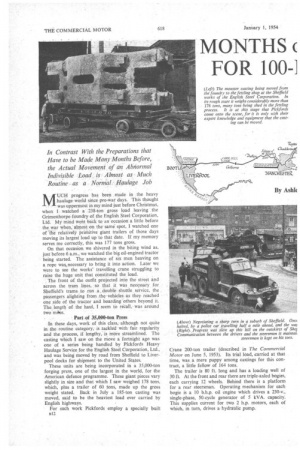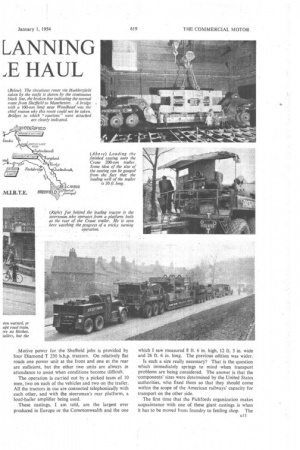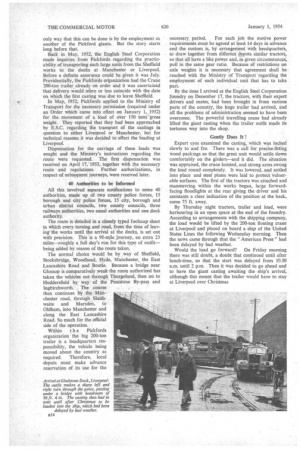MONTHS ( FOR 100-] LANNING JE HAUL
Page 46

Page 47

Page 48

Page 51

If you've noticed an error in this article please click here to report it so we can fix it.
In Contrast With the Preparations that Have to be Made Many Months Before, the Actual Movement of an Abnormal Indivisible Load:. is Almost as Much Routine as a Normal Haulage Job MUCH progress has been made in the heavy haulage world since pre-war days. This thought
was uppermost in my mind just before Christmas, when I watched a 238-ton gross load leaving the Grimesthorpe foundry of the English Steel Corporation, Ltd. MY mind went back to an occasion a little before the war when, almost on the same spot, I watched one of the relatively primitive giant trailers of those days moving its largest load up to that date. If my memory serves me correctly, this was 177 tons gross.
On that occasion we shivered in the biting wind as, just before 6 a.m., we watched the big oil-engined tractor being started. The assistance of six men heaving on a rope was, necessary to bring it into action. Later we were to see the works' travelling crane struggling to raise the huge unit that constituted the load.
The front of the outfit projected into the street and across the tram lines, so that it was necessary for Sheffield's trams to run a, double shuttle service, the passengers alighting from the. vehicles as they reached one side of the tractor and boarding others beyond it. The length of the haul, I seem to recall,was around two mks.
Part of 35,000-too Press
In these days, work of this class, although not quite in the routine category, is _tackled with fair regularity and the process, if lengthy, is More streaMlined. The casting which I saw on the move a fortnight ago was one of a series being handled by Pickfords Heavy Haulage Service for the English Steel Corporation, Ltd., and was being moved by road from Sheffield to Liverpool docks for shipment to the United States.
These units are being incorporated in a 35,000-ton forging press, one of the largest in the world, for the American defence programme. These giant pieces vary slightly in size and that which I saw weighed 178 tons, which, plus a trailer of 60 tons, made up the gross weight stated. Back in July a 185-ton casting was moved, said to be the heaviest load ever carried by English highways.
For such work Pickfords employ a specially built al2 Crane 200-ton trailer (described in The Commercial Motor on June 5, 1953). Its trial load, carried at that time, was a mere puppy among castings for this contract, a little fellow of 164 tons.
The trailer is 80 ft. long and has a loading well of 30 ft. At the front and rear there are triple-axled bogies, each carrying 12 wheels. Behind there is a platform for a rear steersman. Operating mechanism for each bogie is a 10 b.h.p. oil engine which drives a 230-v., single-phase, 50-cycle generator of 5 kVA. capacity. This supplies current for two 2 h.p. motors, each of which, in turn, drives a hydraulic pump.
,Motive power for the Sheffield jobs is provided by four Diamond T 230 b.h.p. tractors. On relatively flat roads one power unit at the front and one at the rear are sufficient, but the other two units are always in attendance to assist when conditions become difficult.
The operation is carried out by a picked team of 10 men, two on each of the vehicles and two on the trailer. All the tractors in use are connected telephonically with each other, and with the steersman's rear platform, a loud-hailer amplifier being used.
These castings, I am told, are the Largest ever produced in Europe or the Commonwealth and the one which I saw measured 8 ft. 6 in. high, 12 ft. 3 in. wide and 26 ft. 6 in. long. The previous edition was wider.
Is such a size really necessary? That is the question which immediately springs to mind when transport problems are being considered. The answer is that the 'components' sizes were determined by the United States authorities, who fixed them so that they should come within the scope of the American railways' capacity for transport on the other side.
The first time that the Pickforcls organization makes acquaintance with one of these giant castings is when it has to be moved from foundry to fettling shop. The 1313
only way that this can be done is by the employment 01 another of the Pickford giants. But the story .starts long before that.
Back in May, 1952, the English Steel Corporation made inquiries from Pickfords regarding the practicability of transporting such large units from the Sheffield works to the docks at Manchester or Liverpool. Before a definite assurance could be given it was July. Providentially, the Pickfords organization had the Crane 200-ton trailer already on order and it was ascertained that delivery would rtiore or less coincide with the date on which the first casting was due to leave Sheffield.
In May, 1952, Pickfords applied to the Ministry of Transport for the necessary permission (required under an Order which came into effect on January 1, 1952) for the movement of a load of over 150 tons gross weight. They reported that they had been approached by E.S.C. regarding the transport of the castings in question to either Liverpool or Manchester, but for technical reasons it was decided to effect the loading at Liverpool.
Dispensation for the carriage of these loads was sought and the Ministry's instructions regarding the route were requested. The first dispensation was received on April 17,1953, together with the necessary route and regulations. Further authorizations, in respect of subsequent journeys, were received later. • 40 Authorities to he Informed All this involved separate notifications to some 40 authorities, made up of two county police. forces, 15 borough and city police forces, 15 city, borough and urban district councils, two county councils, three railways authorities, two canal authorities and one dock authority.
The route is detailed in a closely typed foolscap sheet in which every turning and road, from the time of leaving the works until the arrival at the docks, is setout with precision. This is a 98-mile journey, an extra 23 miles—roughly a full day's run for this type of outfit— being added by reason of the route taken.
The normal choice would be by way of Sheffield, Stocksbridge, Woodhead, Hyde, Manchester, the East Lancashire Road and Bootle. Because a bridge near Glossop is comparatively weak the route authorized has taken the vehicles out through Thurgoland, then on to Huddersfield by way of the Penistone By-pass and Ingbirchworth. The course then continues by the Manchester road, through Slaithwaite and Marsden, to Oldham, into Manchester and along the East Lancashire Road. So much for the official side of the operation.
Within t h e Pickfords organization the• big 200-ton trailer is a headquarters responsibility, the vehicle being moved about the country as required. Therefore, local depots must make advance reservation of its use for the necessary. period. For each job the motive power requirements must be agreed at least 14 days in advance and the custom is, by arrangement with headquarters, to draw together from different depots similar tractor, so that all have a like power and, in given circumstances, pull in the same gear ratio. Because of restrictions on axle weights it is necessary that agreement shall be reached with the Ministry of Transport -regarding the employment of each individual unit that has to take part.
By the time I arrived at the English Steel Corporation foundry on December 17, the tractors, with their expert drivers and mates, had been brought in from various parts of the country, the huge trailer had arrived, and all the problems of administration seemed to have been overcome. The powerful travelling crane had already lifted the giant casting when the trailer outfit made its tortuous way into the shop.
Gently Does It!
Expert eyes examined the casting, which was inched slowly to and fro. There was a call for precise-fitting wood packings so that the great unit would settle down comfortably on the girders—and it did. The situation was appraised, the crane hoisted, and strong arms swans the load round completely. It was lowered, and settled into place and steel plates were laid to protect vulnerable surfaces. The first of the tractors was attached and manceuvring within the works began, large forwardfacing floodlights at the rear giving the driver and his assistants a clear indication of the position at the back, some 75 ft. away.
By Thursday night tractors, trailer and load, were harbouring in an open space at the end of the foundry. According to arrangements with the shipping company, the load would be lifted by the 200-ton floating crane at Liverpool and placed on board a ship of the United States Lines the following Wednesday morning. Then the news came through that the "American Press" had been delayed by bad weather.
Would the load go forward? On Friday morning there was still doubt, a doubt that continued until after lunch-time, so that the start was delayed from 10.30 a.m. until 2 p.m. Then it was decided to go ahead and to have the giant casting awaiting the ship's arrival, although this meant that the trailer would have to stay at Liverpool over Christmas Jobs of this nature are accompanied throughout by one or two Pickfords' representatives travelling by car, and there is also a police escort. The general rule is that one police car travels about half a mile -ahead to warn, and if necessary to halt, all oncoming traffic. As a police ear approaches the boundary of the area in which it operates, the driver radios to the next one so that a car from that authority is ready to take
over. .
. There was something strangely impressive about this monster machine as it moved through the gloom and, with the aid of the rear steering, wriggled round seemingly impossible corners. From time to time,. the drivers of the tractors changed gear together, M a sort of drill movement, 'Working on the word of command given through the loud hailers by the leading driver.
The first of the three bridges where Ministry of Transport special cautions were applied, was encountered at ThurgoIand. Here the vehicles were kept to the centre of the carriageway and travelled dead slow, gear changing being forbidden. The police ensured that there was no other vehicle on the structure during the passage of the unit.
At each of the three bridges where cautions. were enforced-ThurgoIand, Bridge Street (Huddersfield) and Regent Bridge (Manchester and Salford)-liaison had to be made with the appropriate bridge and police authorities so that technical staff should be present at the time, of the crossing, it being forbidden for the vehicle to proceed until they were present. Somewhat similar arrangements also applied in respect of Millers Bridge 'at Bootle.
After an uneventful run to Huddersfield, the outfit reached the Bridge Street• crossing over the River Holme where, in accordance with Ministry instructions, care was taken that the near-side wheels of the, trailer ran approximately 7 ft. from the kerb. Crossing the Pennines was tackled satisfactorily and, with police assistance, the centre of Oldham was traversed in the reverse direction to that of the normal one-way traffic system.
The parking place in Manchester's broad Whitworth Street West was reached on Sunday, three hours ahead of schedule. There the outfit Jay overnight, in readiness to make the crossing of Regent Bridge, over the River Irwell between Manchester and Salford, at about 10.30 on Monday morning. Here again survey staff were ready with chalk markers showing the exact path to be taken. Beneath the bridge, other technicians had all their apparatus set for the measuring of deflections in hundredths of an inch, and it deflected about in.
Typical of the police arrangements for keeping heavy traffic flowing was the plan adopted on the two-way carriageway of Regent Road, Salford. Both lines of vehicles were concentrated in what is normally the outward lane, and the carriageway usually devoted to city bound traffic was reserved for the casting. After an hour or so of ambling at walking pace round the environs of Salford, the massive road train reached East Lancashire Road and the way was clear along the great highway to Liverpool, Bootle and the Gladstone Dock.
There the trailer and its load remained until this week, when the casting was hoisted aboard ship to begin its journey to America.




























































































